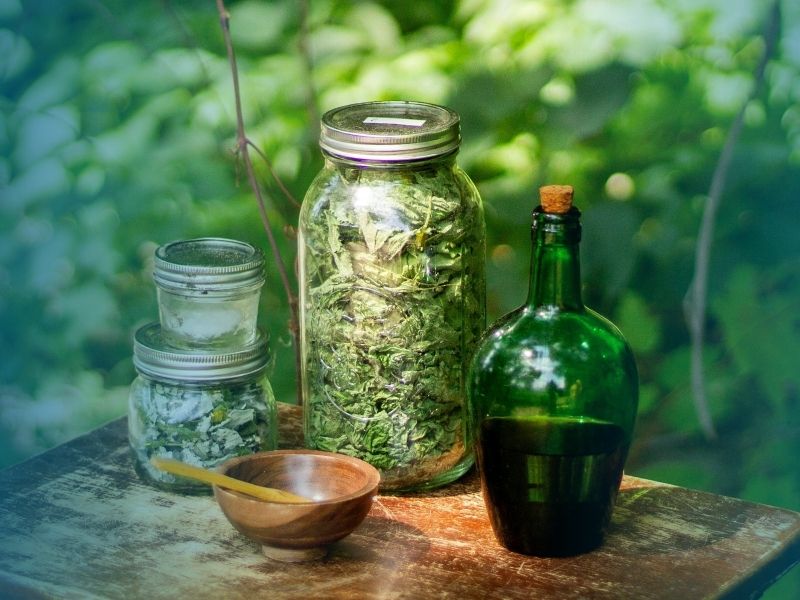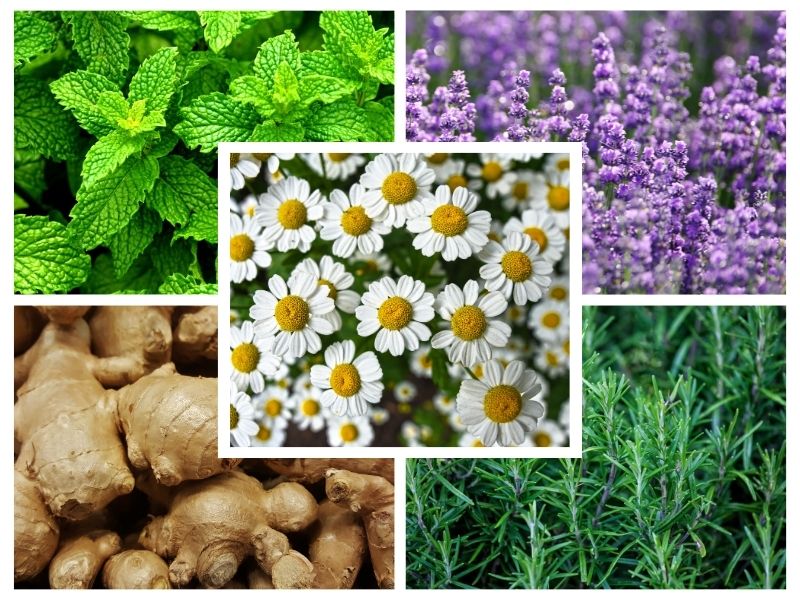Can you relate to this? You go to Thanksgiving dinner at Grandma’s, eat a bit too much, and feel exhausted, full, and uncomfortable for the rest of the evening. I get it–who can resist the gastronomic delights of the traditional holiday feast, especially when it is with loved ones who have prepared the meal?While I always recommend eating a balanced diet full of whole foods, the holidays are often the time of year where we push our limits. The only problem is that you end up feeling bloated, irritable, and generally uncomfortable after over-eating.
Luckily for us, there are several herbal teas that can support normal, healthy digestion during the holidays.
Ginger Tea
Zingiber officinale (Roscoe)
Ginger Zingiber officinale (Roscoe) is a spicy tea that l love. Its notable warming effect is lovely during the chilly weather of fall and winter. Ginger Z. officinale is a popular spice during the holidays with ginger bread, ginger cake, ginger cookies, and (for the kids!) gingerbread people and houses.
Ginger Z. officinale tea is also ideal for normal digestion. A nice cup of ginger Z. officinale tea helps promote normal movement through the digestive tract and elimination.[1] Ginger also aids in the normal digestion of fat, which can be abundant in holiday meals.[2]
Peppermint Tea
Mentha ×piperita (L.)
Peppermint Mentha ×piperita (L.) makes me think of candy canes and sweet after-dinner mints! Traditionally, mint has been used after a meal to ease healthy digestion. It can be in the form of a candy, or if you want to ditch the sugar (which I suggest!), it makes a delicious herbal tea! Additionally, peppermint P. ×piperita supports optimal food transit time and normal elimination.[3]
Cinnamon Tea
Cinnamomum zeylanicum (Blume)
The perfect warming spice for a cold winter day! We all know the holidays are filled with sugary sweets. But did you know that cinnamon C. zeylanicum can support healthy blood sugar levels already in the normal range and soothe and support digestion? Since you’re probably already cooking with cinnamon this winter, save a teaspoon for your evening cup of tea!
German Chamomile Tea
Matricaria recutita (L.)
There’s a reason Peter Rabbit’s mother gave him chamomile tea when he was feeling unwell! Chamomile Matricaria recutita (L.) is another herbal remedy that has been used in folk medicine for centuries. It has traditionally been used to ease the stomach. It’s relaxing qualities are so soothing and gentle, that it’s been traditionally used with children and babies. Caution: Be sure to look up all contraindications and ask your pediatrician before giving chamomile M. recutita (or any herb) to an infant or child. Children under the age of five should not be given more than half a cup of tea per day.[4]
Licorice Tea
Glycyrrhiza glabra (L.)
When thinking of licorice, many think of the imitation-flavored candy. But when purchasing licorice Glycyrrhiza glabra (L.) for medicinal purposes, you need the real thing. Licorice G. glabra is especially soothing to the stomach. Be aware that licorice G. glabra may have side effects, so be sure it is the deglycyrrhizinated kind.[5] Tablets are a common way to take licorice, but a calming tea is a wonderful way to wind down after a big meal. Licorice G. glabra may not mix well with some medications, so be sure to check contraindications and ask your trusted holistic health practitioner before using licorice.
Brewing Your Tummy Teas
Of course, you can brew these herbs individually as teas, or get creative and blend them together. Just be sure to use the correct ratios and check for any contraindications.
Basic Tea Recipe (from the ACHS eBook: Preparing Herbal Teas)
Herb: 1 teaspoon
Purified water: 1 cup
Place your herbs into a ceramic or glass teapot.
Bring the water to a boil. Do not use an aluminum pot.
Turn off the heat and pour the water over the herb.
Cover the pot and let steep for five to 10 minutes.
Strain the tea in a non-aluminum strainer and then drink. Use immediately. Do not store.
As we move into the holiday season, with so many goodies readily available, it’s easy to overeat. While we should do our best to make good choices around our nutrition, these delicious and tasty herbal teas can help support a healthy, happy tummy for the holidays.
This article is for informational purposes only. It is not intended to treat, diagnose, cure, or prevent disease. This article has not been reviewed by the FDA. Always consult with your primary care physician or naturopathic doctor before making any significant changes to your health and wellness routine.
Disclosure of Material Connection: I am a graduate of American College of Healthcare Sciences, the Institution that publishes this blog. However, all opinions are my own. This blog may contain affiliate links. I am disclosing this in accordance with the Federal Trade Commission’s 16 CFR, Part 255: “Guides Concerning the Use of Endorsements and Testimonials in Advertising.”
[1] Rodriguez-Fragoso, L., Reyes-Esparza, J., Burchiel, S., Herrera-Ruiz, D., & Torres, E. (2008). Risks and Benefits of Commonly used Herbal Medicines in México. http://www.ncbi.nlm.nih.gov/pmc/articles/PMC2322858/, 227(1), 125–135. Retrieved from http://www.ncbi.nlm.nih.gov/pmc/articles/PMC2322858/
[2] Prakash, U., & Srinivasan, K. (2011). Fat digestion and absorption in spice-pretreated rats. Journal of the Science of Food and Agriculture., 3(92), 203–210. Retrieved from http://www.ncbi.nlm.nih.gov/pubmed/21918995
[3] Rodriguez-Fragoso, L., Reyes-Esparza, J., Burchiel, S., Herrera-Ruiz, D., & Torres, E. (2008). Risks and Benefits of Commonly used Herbal Medicines in México. http://www.ncbi.nlm.nih.gov/pmc/articles/PMC2322858/, 227(1), 125–135. Retrieved from http://www.ncbi.nlm.nih.gov/pmc/articles/PMC2322858/
[4] German chamomile. (n.d.). Retrieved 23 October 2015, from https://umm.edu/health/medical/altmed/herb/german-chamomile
[5] Graedon, J., & Graedon, T. (2008). Best Choices From the People’s Pharmacy. NAL.




